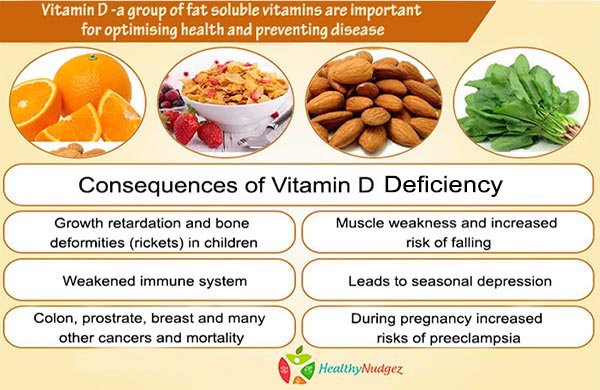Vitamin D -a group of fat soluble vitamins are important for optimizing health and preventing disease
Vitamin D, is a group of fat soluble vitamin, which include vitamin D2 (ergocalciferol) and vitamin D3 (cholecalciferol). Vitamin D is important for optimizing health and preventing disease Vitamin D2 and D3 are both converted to Vitamin D, which is the active form, when the skin is exposed to sunlight (solar ultraviolet B, UVB-.290-320nm). During this process vitamin D2 is converted to vitamin D3 which in turn is converted to Vitamin D. Excessive exposure to UVB rays converts Vitamin D3 into the biologically inactive form and is then not available for use in the body. Vitamin D2 enters the circulation through dietary sources and is available only in the plants, whereas Vitamin D3 is mainly available in non-vegetarian foods.
Vitamin D Deficiency- Causes and Consequences
Recent surveys have reported that vitamin D deficiency is currently prevalent across all age groups, geographic regions and seasons. Data Shows that in India about 70% of the general population is vitamin D deficient. Serum levels of 25(OH)D, below 30 ng/ml (75 nmol/L) are considered to be a sign of vitamin D deficiency.
The main cause of vitamin D deficiency is reduced exposure to solar UVB rays. Anything that interferes with penetration of UVB radiation into the skin effects the synthesis of vitamin D in the body. Sun screen and increased melanin (skin pigmentation), increase the absorption of UVB, thus reducing the skin’s ability to synthesise vitamin D.
Ageing, low fat diets or fat malabsorption are also the causes of vitamin D deficiency. As vitamin D is fat soluble, it is absorbed quickly by the body’s fat cells, so obesity is also one of the common reason for vitamin D deficiency. Certain medicines, such as anti-seizure medicines and glucocorticoids also cause deficiency of vitamin D. All these along with a diet low both in vitamin D and calcium, cause decreased vitamin D pools in the body.
The consequences of vitamin D deficiency are numerous and are not restricted to only the musculoskeletal system, these are:
- Growth retardation and bone deformities (rickets) in children
- Osteopenia and osteoporosis in adults with increased risk of fractures
- Muscle weakness and increased risk of falling
- Weakened immune system
- Leads to seasonal depression
- Colon, prostrate, breast and many other cancers and mortality
- Increased risks of developing Type I Diabetes, multiple sclerosis and hypertension
- During pregnancy increased risks of preeclampsia and
- Increased risk of developing tuberculosis.
Prevention and Treatment of Vitamin D Deficiency:
- Supplementation of vitamin D along with calcium under professional supervision
- Exposure to sunlight of arms and legs for 5-30 minutes between 10:00 am and 3:00 pm
- Maintain ideal body weight
- Check for fat malabsorption and avoid diets very low in fat
- Including vitamin D rich foods in the daily diet along with including calcium in the diet
Dietary Sources of Vitamin D:
- Cod liver oil
- Oily fish especially ocean-raised fishes like tuna, salmon, mackerel and herring
- Oysters
- Sundried mushrooms
- Milk
- Yoghurt
- Soymilk
- Eggs yolk
- Cheese
- Butter and cream both have small amounts of this vitamin
- Fortified breakfast cereals and other cereals, for example oats (read labels)
- Fortified Juices like orange juice (read labels)
- Supplements (should only be consumed with high fat foods for better absorption, such as full cream milk)
Calcium rich foods that also need to be included in daily diet along with vitamin D rich food for maximum benefit are:
- Spinach
- Okra (lady’s finger)
- Soybean
- French beans
- Red beans
- Lentils
- Some fish like salmon, sardines, trout, etc.
- Almonds (also have small amounts of vitamin D)
- Dried figs
- Oats
- Fortified cereals (read labels)
- Fortified juices (read labels)
It is very important to read labels for all packaged foods and to take all vitamin D supplements with high fat foods, as it is absorbed only in the presence of and along with fat into the circulation.

